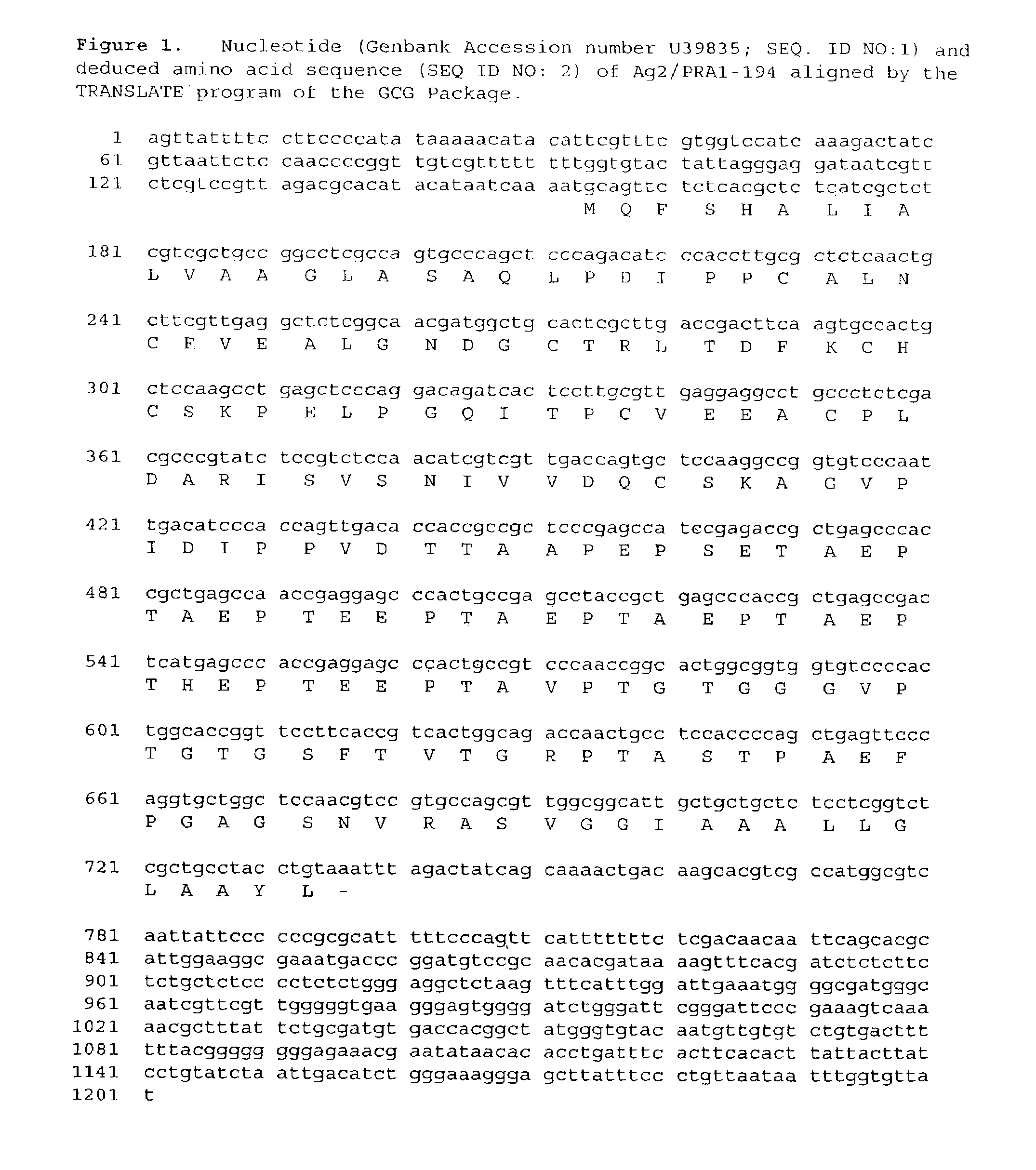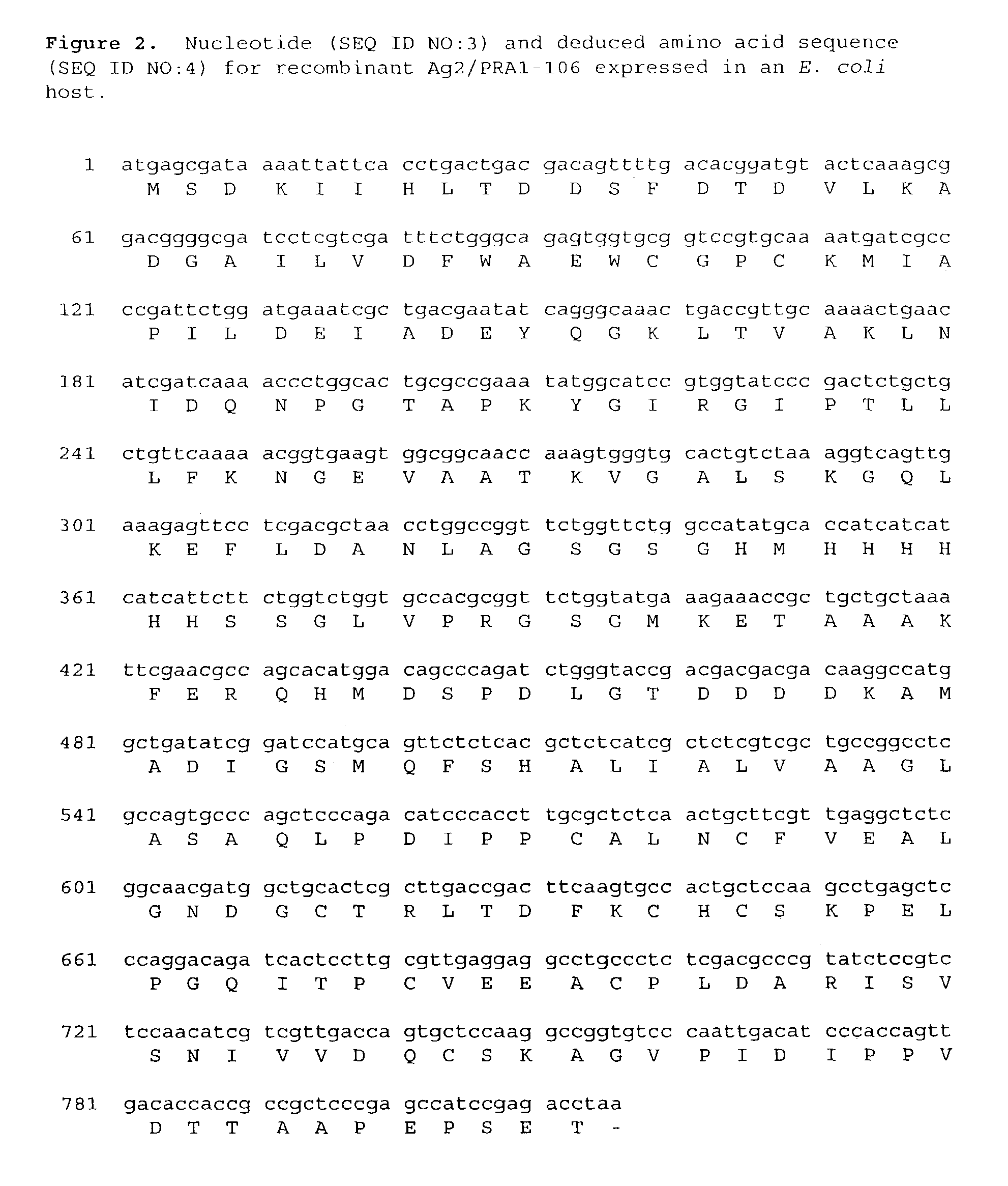Peptides and DNA encoding the peptides useful for immunizations against Coccidioides spp. infections
a technology of peptides and dna, which is applied in the field of pathogenic fungi and immunology, can solve the problems of limited success, unsatisfactory vaccine, and failure to achieve original human vaccine trial success
- Summary
- Abstract
- Description
- Claims
- Application Information
AI Technical Summary
Benefits of technology
Problems solved by technology
Method used
Image
Examples
example 1
Immunoprotection Studies with Recombinant Ag2 / PRA Vaccines Expressed in E. coli
Materials and Methods
[0134]Cloning, Expression, and Characterization of Recombinant Vaccines Design of Ag2 / PRA subunits. Potential antigenic domains were identified in the predicted 194 amino acid sequence of Ag2 / PRA (Dugger, Kris Orsborn, Kara M. Villareal, An Ngyuen, Charles R. Zimmermann, John H. Law and John N. Galgiani. 1996. Cloning and Sequence Analysis of the cDNA for a Protein from Coccidioides immitis with Immunogenic Potential. Biochemical Biophysical Research Communication 218:485–489; Genbank Accession number U39835). We used the antigenicity prediction algorithm of the PEPTIDESTRUCTURE program of the GCG Package (Genetics Computer Group, Madison, Mich. [now Accelrys, San Diego, Calif.]), which analyzes six properties relating to secondary peptide structure and calculates the “antigenic index” as defined for antibody based immune responses to model proteins, and the ANTIGEN program of PC Gen...
example 2
Protection Studies with S. cerevisiae Expressed Ag2 / PRA1-106 Polypeptide Antigen Used Singly or in Combination with a Second Coccidioides spp. Antigen
Materials and Methods
[0157]Cloning and Expression of Ag2 / PRA1-106 in Saccharomyces cerevisiae
[0158]pCVP20.17 was used as a template in a PCR catalyzed by Pfu DNA polymerase for 35 cycles as described in Example 1 above. The sense primer was P1 (5′CCGGATCCATGCAGTTCTCTCACGCT 3′)(Table 1 and SEQ ID NO:12) and the antisense primer P2 (5′ CCCGTCGACTTAGGTCTCGGATGGCTC 3′)(SEQ ID NO:13), each of which includes a restriction site to facilitate subcloning. The resulting 338 bp product encoding the Ag2 / PRA1-106 was purified using NucleoSpin Kit (Clontech, Palo Alto, Calif.), digested with BamHI and SalI, and ligated into the BamHI / SalI sites of the 7190 bp yeast expression vector YEpFLAG-1 (Sigma, St. Louis, Mo.) using the manufacturer's protocols. The YEpFLAG-1-Ag2 / PRA1-106 construct was used to transform E. coli DH5α by standard techniques, an...
example 3
Ex-vivo Production of Interferon-Gamma in Response to Single and Combination Antigen Vaccines
Materials and Methods
[0168]Female, 17-weeks old C57B1 / 6 mice were purchased from Harlan-Sprague-Dawley (Indianapolis, Ind.) and maintained in conventional housing under microisolation lids. Mice were divided into groups of 3 animals each for experimental testing of the recombinant polypeptide antigens rAg2 / PRA1-106 (yeast-derived), rCsa (obtained from Dr. Garry Cole), rAg2 / PRA1-106+rCsa, or adjuvant controls. For vaccination with recombinant peptides, the protein was suspended in 0.9% sterile saline and was combined with a mixture of 10 μg of CpG and 25 μg of MPL (Corixa, Inc., Hamilton, Mont.) adjuvants. Mice were vaccinated twice 14 days apart subcutaneously in the inguinal region with doses of 1 μg of protein of each antigen or control adjuvants in a volume of 200 μl. Thirty-seven days after the last immunization, mice were euthanized and spleens were aseptically removed from animals, pro...
PUM
| Property | Measurement | Unit |
|---|---|---|
| temperature | aaaaa | aaaaa |
| temperature | aaaaa | aaaaa |
| pH | aaaaa | aaaaa |
Abstract
Description
Claims
Application Information
 Login to View More
Login to View More - R&D
- Intellectual Property
- Life Sciences
- Materials
- Tech Scout
- Unparalleled Data Quality
- Higher Quality Content
- 60% Fewer Hallucinations
Browse by: Latest US Patents, China's latest patents, Technical Efficacy Thesaurus, Application Domain, Technology Topic, Popular Technical Reports.
© 2025 PatSnap. All rights reserved.Legal|Privacy policy|Modern Slavery Act Transparency Statement|Sitemap|About US| Contact US: help@patsnap.com



